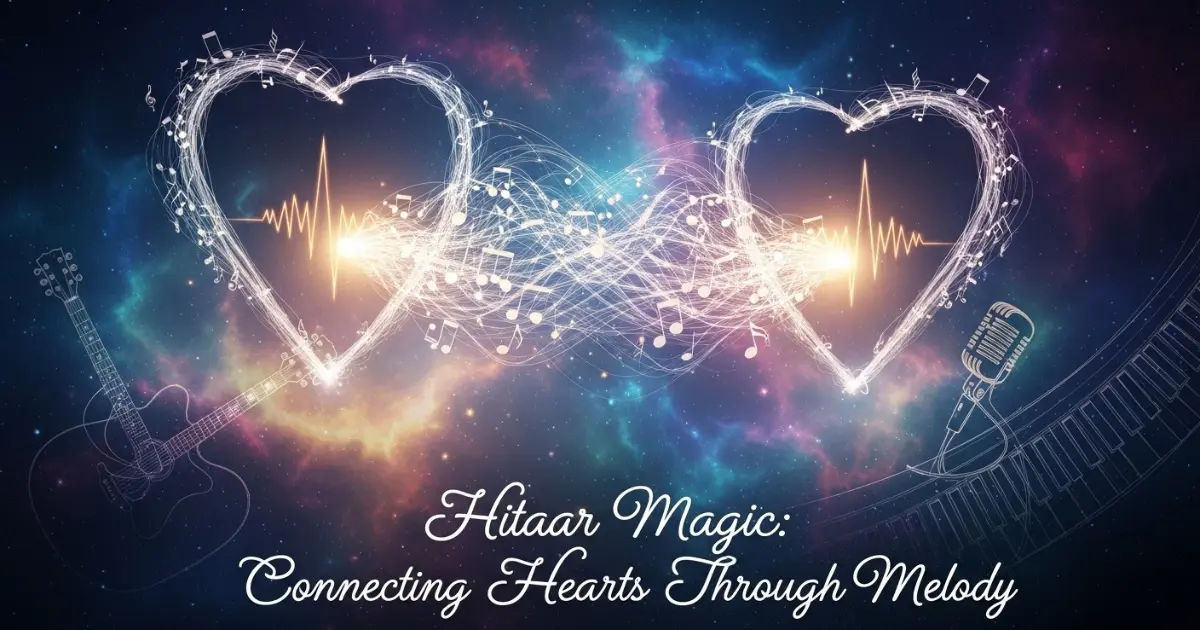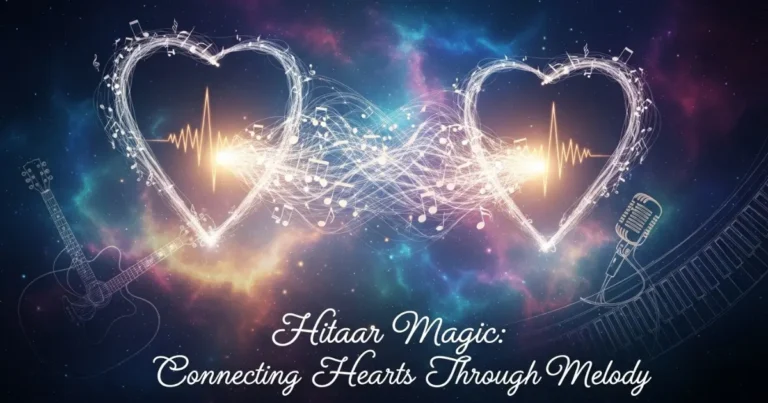
Music has always been humanity’s universal language—an invisible bridge that connects people beyond words, borders, and beliefs. In this vast symphony of global sounds, Hitaar has emerged as a name that resonates with innovation, passion, and emotional depth. A symbol of both tradition and modernity, Hitaar embodies the art of storytelling through sound, creating melodies that touch the soul and unite listeners worldwide.
Whether experienced as an instrument, a musical movement, or a philosophy, Hitaar represents a new era of connection through sound. It’s not just about playing notes—it’s about expressing emotions, preserving culture, and embracing creativity.
Understanding Hitaar
The word Hitaar finds its roots in the fusion of “harmony” and “guitar,” symbolizing a contemporary approach to music that blends classical craftsmanship with innovative design. More than an instrument, Hitaar is a creative concept—where rhythm meets emotion, and melody becomes a bridge between heart and soul.
Often described as a modern evolution of string instruments, the Hitaar combines acoustic depth with electronic adaptability, offering musicians the freedom to experiment across genres. From soft folk tones to powerful digital riffs, its versatility allows for endless musical possibilities.
The Origin and Evolution of Hitaar
The story of Hitaar begins with the desire to create something beyond conventional instruments—something that could carry the warmth of acoustic sound while embracing the flexibility of modern music technology.
Early prototypes were designed by passionate musicians seeking a more soulful connection with their instruments. Over time, it evolved into a refined creation that balances design, ergonomics, and sound clarity.
This evolution was not just technical—it was emotional. Musicians who played the Hitaar often described it as an extension of their inner voice, capable of transforming feelings into melodies.
The Design Philosophy Behind Hitaar
Every curve, string, and note in the Hitaar serves a purpose. Its design philosophy revolves around three core elements—simplicity, resonance, and emotion.
-
Simplicity: Easy to handle for beginners yet sophisticated for experts.
-
Resonance: Crafted to produce warm, organic tones that echo naturally.
-
Emotion: Every vibration is tuned to amplify expressive depth.
By combining natural materials with modern technology, the Hitaar achieves a sound that feels both familiar and futuristic.
How Hitaar Connects Hearts Through Melody
Music’s emotional power lies in its ability to connect people—and Hitaar amplifies this essence beautifully. When played, it produces tones that evoke deep emotional responses, creating shared experiences among listeners.
The Emotional Language of Hitaar
Each note of the Hitaar carries emotion—joy, sorrow, nostalgia, or hope. Musicians use it to tell stories without words, turning moments into melodies that resonate across cultures.
Hitaar as a Symbol of Unity
From community jam sessions to professional concerts, Hitaar brings people together. It bridges cultural gaps by creating a shared space for creativity, harmony, and mutual understanding.
Hitaar in Modern Music
In today’s diverse musical landscape, Hitaar is quickly becoming a favorite among artists exploring fusion genres. Its adaptability makes it perfect for world music, electronic experimentation, and soulful acoustic performances.
Musicians appreciate its smooth tonal transitions, responsive touch, and the ability to blend seamlessly with digital production tools. Whether in live performances or studio recordings, Hitaar stands out as a modern instrument for the modern artist.
The Sound of Hitaar: A Blend of Past and Future
One of the most fascinating qualities of the Hitaar is how it merges the warmth of traditional string instruments with the precision of electronic sound engineering.
-
Acoustic Mode: Produces deep, resonant notes ideal for unplugged performances.
-
Electronic Mode: Offers amplified clarity and customizable sound effects.
-
Hybrid Performance: Combines both worlds for a layered, multidimensional sound.
This versatility ensures that Hit-aar remains relevant across all genres—from jazz and blues to rock, pop, and world fusion.
Craftsmanship and Technology
Every Hit-aar is a work of art, handcrafted by skilled artisans who respect the legacy of string instruments while integrating state-of-the-art innovations.
Natural Craftsmanship
Sustainably sourced woods, precision string tension, and ergonomic design make each Hit-aar unique. Its organic feel enhances the musician’s connection with the instrument.
Modern Innovation
Built-in digital interfaces, tuning memory, and Bluetooth connectivity allow seamless integration with recording equipment and performance systems.
The fusion of craftsmanship and technology makes Hitaar a bridge between human touch and digital expression.
Why Musicians Love the Hitaar
Musicians describe playing the Hit-aar as a transformative experience—one that feels both grounding and liberating. Here’s why it has gained such passionate fans:
-
Expressive Range: Capable of capturing the subtlest emotional nuances.
-
Adaptability: Works for multiple genres and performance environments.
-
Aesthetic Appeal: Elegant, sleek design that’s as beautiful as it is functional.
-
Ease of Use: Ideal for both beginners and professionals.
-
Cultural Versatility: Resonates with audiences across the globe.
Hitaar in Cultural and Global Contexts
Music connects civilizations, and Hit-aar has already begun finding its place in diverse cultural settings. In India, it’s used in fusion concerts blending classical ragas with modern beats. In Europe, it complements acoustic sessions and film scores.
By transcending geographical and musical boundaries, Hitaar embodies the spirit of global harmony. It is more than an instrument—it’s a movement encouraging creative collaboration across cultures.
The Emotional Science Behind Hitaar’s Music
Sound therapy experts have begun exploring the Hitaar’s tonal vibrations for their calming and mood-enhancing properties. The frequency range it produces often aligns with the natural rhythm of human emotion.
-
Lower tones calm the mind and reduce stress.
-
Mid-range frequencies evoke warmth and emotional balance.
-
Higher tones inspire creativity and alertness.
This emotional science explains why listeners often feel deeply moved after hearing a Hitaar performance.
Learning to Play Hitaar
Learning the Hit-aar is both a joyful and introspective journey. Its intuitive structure makes it accessible to beginners, while its complexity offers room for lifelong exploration.
For Beginners:
Start with simple chord transitions and strumming patterns. Focus on feeling the rhythm rather than rushing technique.
For Professionals:
Experiment with hybrid tuning, electronic effects, and fusion techniques to push the boundaries of traditional sound.
Online platforms and music academies are now offering specialized Hit-aar tutorials, making it easier for aspiring musicians to join this creative wave.
Hitaar in the Digital Age
Technology has revolutionized music production, and Hit-aar embraces that transformation. Through digital connectivity, musicians can record, mix, and perform live with advanced audio control.
Virtual collaborations have made it possible for artists worldwide to compose together, using the Hitaar as a shared creative medium. This harmony of human touch and digital technology reflects the very essence of modern art.
Hitaar and Emotional Healing
In music therapy, instruments like Hit-aar are used to help individuals release stress, anxiety, and emotional tension. Its soft, resonant tones are known to encourage relaxation, mindfulness, and self-expression.
Hospitals, wellness centers, and yoga studios are beginning to use Hitaar sessions as part of holistic healing programs—where sound truly becomes medicine for the soul.
Sustainability in Hitaar Production
True to its harmonious spirit, Hit-aar production emphasizes sustainability. Manufacturers source eco-friendly materials, minimize waste, and prioritize ethical labor practices.
This commitment ensures that the beauty of music doesn’t come at the cost of environmental or social well-being. It’s an instrument that sounds good—and feels good to own.
Future of Hitaar in Music
The future looks bright for Hit-aar as musicians continue to explore its creative potential. With rising global interest in cultural fusion, it’s poised to become a staple in world music.
Upcoming models are rumored to include smart tuning, interactive LED interfaces, and AI-assisted sound modulation—making Hit-aar not just an instrument, but a symbol of music’s evolution.
Conclusion
The Hitaar is more than an instrument—it’s a revolution in sound, design, and emotional connection. Its melodies bridge hearts, cultures, and generations, proving that music truly has the power to unite.
In an age where technology often distances people, Hit-aar reminds us of the profound beauty of human expression. It is a melody born from passion, shaped by innovation, and destined to connect hearts across the world.






